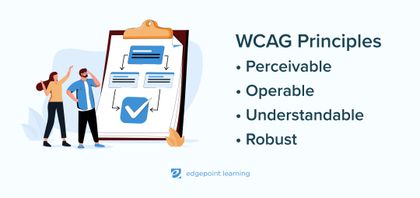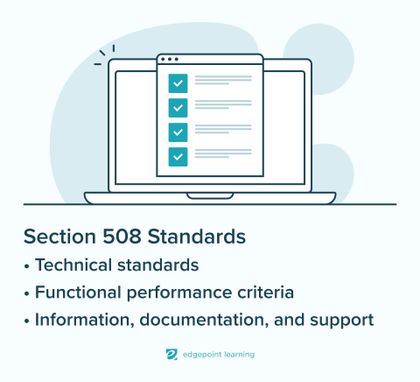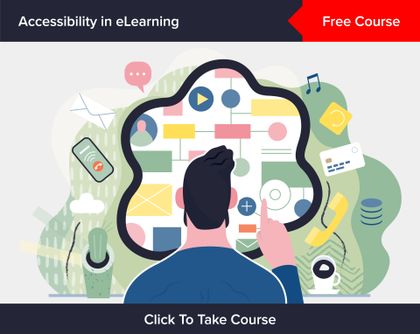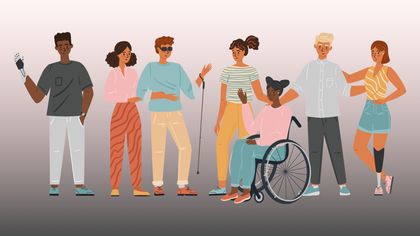How to Design Accessible eLearning: 10 Guidelines
Corey Bleich
🍿🍿 9 min. read
The rise of eLearning has revolutionized the way we learn and access training. With online courses, webinars, and virtual classrooms becoming increasingly popular, it's important to ensure that these resources are accessible to all learners, including those with visual, hearing, or physical disabilities. Designing accessible eLearning programs isn’t a nice-to-have nowadays; it’s crucial.
By following the guidelines in this post, you'll ensure that your courses are inclusive, and all learners have an equal opportunity to benefit from your eLearning programs. You’ll also find a free introductory course about accessible eLearning to share with your team to get started!
🔍 What you’ll find in this post
What is accessible eLearning?
Accessible eLearning ensures your training is inclusive to all your users. It’s developed in such a way that users with visual, auditory, speech, dexterity, cognitive, mobility, and other disabilities can engage with content easily and effectively. Beyond the intentional design of the eLearning, it may also be paired with assistive devices and technology, as necessary.
If you think your employees aren’t facing challenges, think again. An estimated 10% of the population is diagnosed with dyslexia (with many more undiagnosed), and an additional 12% of U.S. adults are disabled in another way. Chances are also good that you have employees with hidden disabilities that need accommodation.
Accessibility is important in a few other ways, too. By complying with accessible eLearning guidelines, you can serve your audience with one training course, avoiding the need to manage multiple versions. There are also accessibility rules you may need to follow to avoid legal risk.
What are accessible eLearning guidelines and laws?
There are two major accessibility guidelines that impact eLearning: Section 508 compliance and Web Content Accessibility Guidelines (WCAG).
In the early years of the 21st century, few people understood how important and widespread the internet might become; however, this changed quickly.
In December of 2000, the Section 508 Standards for Electronic and Information Technology were formally laid out as an amendment to the United States Rehabilitation Act of 1973. Section 508 requires electronic and information technology used by Federal agencies to be accessible to individuals with disabilities. This law applies to all types of electronic content, including eLearning.
In September of 2018, the EU Web Accessibility Directive required all public websites and apps in Europe to meet the standards of the Web Content Accessibility Guidelines (WCAG). These Guidelines were created by the World Wide Web Consortium (W3C) to help make web content more accessible to people with disabilities, as we’ll discuss in more detail.
Both of these standards look to the future with the goal of technology access for all. However, it’s important to understand that these guidelines were not created specifically for eLearning. Because of that, there is some gray area when applying these rules to eLearning. You’ll need to work with your HR, legal, and compliance teams to determine the best approach for your company.
Main WCAG principles and guidelines
The World Wide Web Consortium (W3C) consists of not only W3C staff but also members of the public working together to address common barriers to access for people with disabilities.
The three levels of WCAG – A, AA, and AAA – denote the level of accessibility, with A being the very minimum level and AAA being accessible to all. Most companies aim for AA, and larger companies may aim higher.
In 2018, the EU Web Accessibility Directive required public-facing websites and apps to adopt these standards. Although these standards are not legally required in the U.S. yet, consider these WCAG guidelines as technology best practices that make your eLearning accessible anywhere in the world. This is especially important for global organizations that train employees in European countries.
These guidelines can be broken into four main principles:
- Perceivable: Information must be shared in a way that all users can perceive
- Operable: The user interface must be operable by all users
- Understandable: All content and navigation must be understandable and intuitive to users
- Robust: The project must be compatible with assistive technology
In our accessible eLearning guidelines and tips below, we’ll cover major ways to comply with each of these principles.

Section 508 standards
By familiarizing yourself with Section 508 standards, you can ensure that your eLearning materials are accessible to everyone, regardless of any disabilities they may have. This not only promotes inclusivity and diversity but also ensures that all employees can access and benefit from the training.
Section 508 standards cover three crucial areas:
- Technical standards include requirements for ensuring that eLearning materials are compatible with assistive technologies, such as screen readers and voice recognition software
- Functional performance criteria ensure that eLearning materials can be used by individuals with disabilities, such as those with hearing or visual impairments
- Information, documentation, and support require that eLearning materials are accompanied by accessible documentation and support services
Familiarize yourself with these standards, and the guidelines below, before you start to ensure you have the tools to meet everyone’s needs. Failing to meet these standards could be discriminatory and may even lead to legal repercussions.

How do I make my online training accessible?
You would not deny a wheelchair-bound employee ramp access, and the same is true for designing accessible eLearning. Accessibility means giving all employees the appropriate tools needed to do their job and participate in all professional development activities.
Follow these principles and guidelines for designing accessible eLearning courses for your employees:
- Understand the types of challenges learners may face
- Design with the end user in mind
- Check your language
- Ensure text content is perceivable by all
- Make images, audio, and video perceivable by all
- Make navigation easier
- Avoid certain interactive activities
- Keep an eye out for new technology
- Provide access to assistance
- Measure your accessibility
While these guidelines are important, it’s just as crucial that your full team understands them and why they’re important. We’ve made it easy by developing a free course that you can share with your team to get them up to speed on this topic.

1. Understand the types of challenges learners might face
Auditory, visual, mobility, neurological, and cognitive disabilities exist across a wide spectrum and in varying degrees. Familiarize yourself with the types of disabilities and best practices for design before you begin.
Also, imagine what your learner might experience by considering these questions:
- Will users know how to navigate a course, or is it confusing?
- Does your course work well with screen readers and keyboard tools, or does it require a mouse?
- Can users pause or replay content?
- Are page titles and menus easy to navigate?
- Do you provide easy-to-access tutorials or support?
Think of how frustrating poor design could become in the future and plan for adjustments.
2. Design with the end user in mind
Start the design of your eLearning courses with an understanding of who will be using them. This may seem like common sense, but you might be surprised by how many companies complete due diligence when it comes to figuring out course objectives, only to ignore the end user and their needs for access.
👉Learn more: A high-quality training needs analysis considers both course objectives and who is going to be meeting them, not only for current learners but also for those to come.
3. Check your language
Avoid idioms, jargon, acronyms, or other unusual words. To make truly accessible eLearning programs, write content at an 8th grade reading level with clear and precise language.
4. Ensure text content is perceivable by all
First, make sure that all text is on screen and narrated exactly as written, word-for-word – or that a transcript is readily available for those who need to read instead of hear the content.
Ensure that all content is distinguishable, with accessible colors, visual contrast, text size, and fonts. Font color, size, and type in particular all make a difference when thinking about accessible eLearning.
Generally, simple fonts like Arial and Helvetica work best on a medium- to high-contrast background. Avoid using font characteristics (e.g., bold and italics) to create meaning, as many screen readers will not pick up on this.
Also avoid overusing ultra high-contrast fonts and backgrounds, as this can prove tiring (for all learners!) over time. Consider offering more white space on each screen to provide a rest for the eyes.
5. Make images, audio, and videos perceivable by all
Images and graphics can be challenging for many different kinds of impairments. And audio can be difficult as well.
For screen readers for the visually impaired, use headings for text and clearly-written alt text for images to properly organize and explain the text and graphics as they relate to each other. Alt text is not necessary for purely decorative images, as long as the learner does not miss any context if they can’t see them. Using charts and graphs? Ensure they include alt text that offers context to visually-impaired users.
For audio and video, use closed captioning and audio description or descriptive text. Audio descriptions with videos can include descriptions of scenes, actor expressions, and more. Check that background audio levels don’t make it hard to perceive any audio content.
👉Learn more: Find Harvard’s Digital Accessibility website for more information
6. Make navigation easier
Using simple, direct navigation and menu elements is best for all aspects of your eLearning courses and all users.
For example, “Click here” is a black hole when it comes to navigational accessibility, while “click ‘Next’” is much more straightforward.
You want to make things as predictable as possible, with no unexpected changes or hidden content. Also avoid branching scenarios, and instead stick to linear navigation, when possible.
7. Avoid certain interactive activities
Rethink activities that may be difficult for those with visual or mobility disabilities. Best practices generally include avoiding the following activities in your courses:
- Drag-and-drop or matching activities
- On-screen tabs
- User typed information
- Click-to-reveal buttons
- Visual-based interactions, like hot spots
- “Select all that apply” style questions
If any of these are a crucial part of your design, add easy keyboard shortcuts for those who need them. All of that being said, compliant courses don’t mean boring. Scenario-based learning is a great way to drive engagement with story.
👉Learn more: How to use scenarios to create better eLearning training
8. Keep an eye out for new technology
You don’t have to reinvent the wheel here – new technology for designing accessible eLearning is popping up every day.
From voice-to-text apps from Google to new ways to ditch standard keyboard entry, new accessibility technology makes well-planned eLearning easier.
9. Provide access to assistance
Make sure that all of your accessible eLearning courses come with help. When possible, give learners multiple methods of contact to ask for help, including live chat, phone, and email. This offers all employees a way to get assistance that works best for them.
10. Measure the accessibility of your eLearning design
When your eLearning course is about to launch, take the time (and spend the money) to make sure it is truly accessible.
Choose accessibility testing standards from the WCAG (at a minimum, AA) and run through all aspects of your course to see if it meets that standard. If you find it difficult to figure out just how accessible it is, ask for volunteers to beta test your course. You will get good information on what changes to make before you go live. Another option for some types of disability is to request a free scan of your site to see how it measures up.
Towards better and more accessible eLearning
Accessible eLearning benefits everyone with its intentional, thoughtful design that highlights the most important information and presents it in a clear, informative way.
At EdgePoint Learning, we’re particularly passionate about this issue. For help with designing accessible eLearning, you need a company that has proven AA or AAA level success. We understand the importance of creating accessible eLearning courses and can help with everything from minor changes to full-service course development. Get in touch today to get started.

